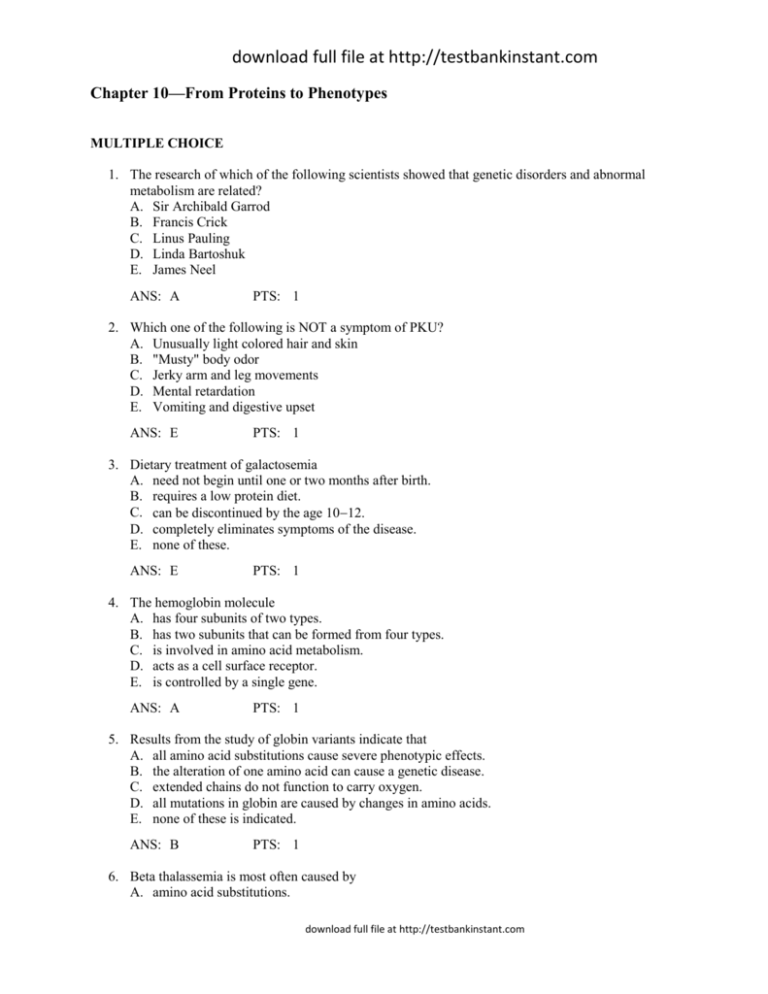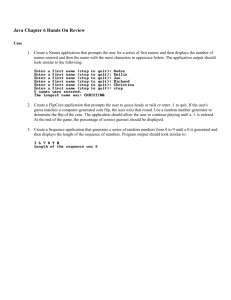Free sample of Test Bank for Human Heredity Principles
advertisement

download full file at http://testbankinstant.com Chapter 10—From Proteins to Phenotypes MULTIPLE CHOICE 1. The research of which of the following scientists showed that genetic disorders and abnormal metabolism are related? A. Sir Archibald Garrod B. Francis Crick C. Linus Pauling D. Linda Bartoshuk E. James Neel ANS: A PTS: 1 2. Which one of the following is NOT a symptom of PKU? A. Unusually light colored hair and skin B. "Musty" body odor C. Jerky arm and leg movements D. Mental retardation E. Vomiting and digestive upset ANS: E PTS: 1 3. Dietary treatment of galactosemia A. need not begin until one or two months after birth. B. requires a low protein diet. C. can be discontinued by the age 1012. D. completely eliminates symptoms of the disease. E. none of these. ANS: E PTS: 1 4. The hemoglobin molecule A. has four subunits of two types. B. has two subunits that can be formed from four types. C. is involved in amino acid metabolism. D. acts as a cell surface receptor. E. is controlled by a single gene. ANS: A PTS: 1 5. Results from the study of globin variants indicate that A. all amino acid substitutions cause severe phenotypic effects. B. the alteration of one amino acid can cause a genetic disease. C. extended chains do not function to carry oxygen. D. all mutations in globin are caused by changes in amino acids. E. none of these is indicated. ANS: B PTS: 1 6. Beta thalassemia is most often caused by A. amino acid substitutions. download full file at http://testbankinstant.com download full file at http://testbankinstant.com B. C. D. E. extended chains in beta globin. lowered or absent synthesis of beta globin. excessive synthesis of beta globin. altered rates of oxygen transport. ANS: C PTS: 1 7. The existence of differential drug sensitivity serves to reinforce the idea that A. many people carry genetic defects. B. each individual is biologically and biochemically unique. C. drugs need to be more closely regulated. D. metabolic blocks are a widespread phenomenon. E. none of these is reinforced. ANS: B PTS: 1 8. The nervous system damage symptomatic of untreated PKU is due to A. too much phenylalanine being transported into nerve cells. B. too few of the other seven neutral amino acids being transported into nerve cells. C. accumulation of the breakdown products of phenylalanine in nerve cells. D. none of these. E. it is not clearly known. ANS: E PTS: 1 9. What substance accumulates in the blood of people with galactosemia? A. Galactose B. Glucose C. Lactose D. Galactose-1-phosphate E. UDP galactose ANS: D PTS: 1 10. What is the nature of the genetic mutation that causes lactose intolerance? A. It is a dominant mutation that prevents lactase production. B. It is a dominant mutation that causes a decline in adult lactase levels. C. It is a recessive mutation that prevents lactase production. D. It is a recessive mutation that causes a decline in adult lactase levels. E. It is an X-linked mutation that prevents lactase production. ANS: D PTS: 1 11. What actually happens to the blood cells of people with sickle cell anemia that causes the cells to change their shape ("sickle")? A. Polymerization of hemoglobin molecules into long fibers. B. Destruction of the hemoglobin molecules. C. Loss of hemoglobin through leaky cell membranes. D. Attachment of phosphate groups to the hemoglobin molecules. E. Binding of methyl groups to the heme group of the hemoglobin molecule. ANS: A PTS: 1 download full file at http://testbankinstant.com download full file at http://testbankinstant.com 12. The compound that Dr. Folling isolated from the urine of the Egeland children was ____________. A. phenylalanine D. phtalamine B. pyruvic acid E. pertussic acid C. phenylpyruvic acid ANS: C PTS: 1 13. The presence of phenylpyruvic acid in urine is an indicator of ___________. A. heart disease D. spina bifida B. colon cancer E. more than one of these C. mental retardation ANS: C PTS: 1 14. PKU is a recessive disorder. If a woman who has PKU has a child, what is the child’s possible genotype? A. Homozygous dominant. B. Homozygous recessive. C. Heterozygous. D. The genotype could be any one of these. E. There is not enough information to determine the child’s genotype. ANS: D PTS: 1 15. Antonio is 27, has a severely enlarged liver, and has a kidney infection. The inherited disease Antonio has is most likely ____________. A. glycogen storage disease D. PKU B. Pompe disease E. lactose intolerance C. amylopectinosis ANS: A PTS: 1 16. The element to which oxygen (O2) binds in a hemoglobin molecule is ___________. A. nitrogen D. potassium B. carbon E. phosphorous C. iron ANS: C PTS: 1 17. Supertasters for the chemical PTC are ____________. A. homozygous dominant B. heterozygous C. homozygous recessive D. either homozygous dominant or homozygous recessive E. either homozygous dominant or heterozygous ANS: A PTS: 1 18. Almost 70 percent of women with breast cancer are estrogen-senstive. What does this mean? A. They are made ill with prescriptions of estrogen. B. Only a small amount of estrogen can exacerbate their symptoms. C. Their own natural estrogen encourages the growth of cancer cells. D. Their cancers go into remission with increased uptake of estrogen. download full file at http://testbankinstant.com download full file at http://testbankinstant.com E. They do not produce their own estrogen. ANS: C PTS: 1 TRUE/FALSE 1. PKU results from a failure to convert tyrosine to phenylalanine. ANS: F PTS: 1 2. The uptake of neutral amino acids such as leucine, histidine, and valine is inhibited in brain cells of PKU individuals. ANS: T PTS: 1 3. Hormone therapy, if administered early, is effective in treating genetic goitrous cretinism. ANS: T PTS: 1 4. All metabolic disorders result in serious phenotypic consequences. ANS: F PTS: 1 5. An essential amino acid is defined as one that is not produced by the body. ANS: T PTS: 1 6. There are no mandatory screening programs for genetic defects such as PKU and galactosemia in newborns. ANS: F PTS: 1 7. Familial hypercholesterolemia is associated with a defect in mitochondrial protein synthesis. ANS: F PTS: 1 8. Thalassemias are hemoglobin disorders in which the production of alpha and beta chains are out of balance. ANS: T PTS: 1 9. Large scale alterations of the amino acid structure in alpha globin are the cause of sickle cell anemia. ANS: F PTS: 1 10. Fetal hemoglobin functions adequately in the fetus but is ineffective in adults. ANS: F PTS: 1 11. People who can taste PTC have been shown to be more likely than non-tasters to dislike broccoli and Brussels sprouts. download full file at http://testbankinstant.com download full file at http://testbankinstant.com ANS: T PTS: 1 12. Lactose intolerance is caused by a mutation in the gene that codes for lactase. ANS: T PTS: 1 13. Hydroxyurea has been shown to switch off cell division. ANS: T PTS: 1 14. Use of succinylcholine as an anaesthetic is very dangerous for people with a genotype for the fast-acting form of the enzyme serum cholinesterase. ANS: F PTS: 1 COMPLETION 1. Garrod called enzyme defects ____________________. ANS: inborn errors of metabolism PTS: 1 2. Phenylketonuria is a result of a deficiency of the enzyme ____________________. ANS: phenylalanine hydroxylase PTS: 1 3. The molecular defect in sickle cell anemia is known to reside at the position ____________________ of the ____________________ globin ANS: 6; beta PTS: 1 4. Some success has been achieved in efforts to treat sickle cell disease by the process of ____________________. ANS: gene switching PTS: 1 5. The symptoms of alkaptonuria result from a build-up of ____________________ in the blood. ANS: homogentisic acid PTS: 1 download full file at http://testbankinstant.com download full file at http://testbankinstant.com 6. A person with the genotype GD/g for the galactosemia gene would have ____________________ of the normal level of galactose-1-phosphate uridyl transferase. ANS: one-fourth PTS: 1 7. Genetic goitrous cretinism is caused by lack of the enzyme to synthesize ____________________ from phenylalanine. ANS: thyroid hormone PTS: 1 8. Different genotypes for the CYP2D6 gene produce significantly different responses to tamoxifen, the medication of choice for treatment of most cases of ____________________. ANS: breast cancer PTS: 1 9. Paraoxonase converts the insecticide ____________________ into a toxic substance called paraoxon. ANS: parathion PTS: 1 10. In humans, ____________________ of the 20 amino acids are "non-essential" amino acids. ANS: 11 PTS: 1 11. Linus Pauling is credited with work that established ____________________ as the first "molecular disease." ANS: sickle cell anemia PTS: 1 12. The chemical compound that acts as a reactant in an enzyme mediated reaction is called a ____________. ANS: substrate PTS: 1 13. In people who have PKU, phenylalanine cannot be converted into the amino acid ____________. ANS: tyrosine download full file at http://testbankinstant.com download full file at http://testbankinstant.com PTS: 1 14. The inability to break down galactose is the genetic disorder called ____________. ANS: galactosemia PTS: 1 15. The enzyme lactase splits the lactose molecule into ____________ and ____________. ANS: glucose; galactose PTS: 1 16. The drug used to treat sickle cell anemia that causes elevated levels of fetal hemoglobin is ____________. ANS: hydroxyurea PTS: 1 17. The study of genetic variations that affect people’s responses to environmental chemicals is called _____________. ANS: ecogenetics PTS: 1 SHORT ANSWER 1. In Chapter 4, two forms of bleeder's disease (hemophilia A and hemophilia B) were described. Each is deficient in a clotting factor. What would you predict are the clotting capacities of a mixture of blood from these two disorders? Why? ANS: Answer not provided. PTS: 1 2. Certain traits in humans are incompletely penetrant, or show variations in expressivity. Can you suggest a biochemical explanation for these observations in such cases caused by a metabolic error? ANS: Answer not provided. PTS: 1 3. In most cases, mutations in metabolic pathways produce a recessive trait. Suggest how a mutation in a metabolic pathway might produce a dominant condition. ANS: download full file at http://testbankinstant.com download full file at http://testbankinstant.com Answer not provided. PTS: 1 4. Why do you think some heterozygotes produce only half the normal amount of a given enzyme and yet have a normal phenotype? ANS: Answer not provided. PTS: 1 5. Why must dietary therapy for PKU be instituted soon after birth? ANS: Answer not provided. PTS: 1 6. Show how the environment, extrauterine and intrauterine factors can influence the expression of PKU. ANS: Answer not provided. PTS: 1 7. Discuss the various possible effects of the loss of the activity of an enzyme. ANS: Answer not provided. PTS: 1 8. Discuss therapeutic approaches in metabolic diseases. ANS: Answer not provided. PTS: 1 9. What does the chapter's section on pharmacogenetics and ecogenetics tell us about the issue of the relative safety of chemicals sold to the public and used in industry? ANS: Answer not provided. PTS: 1 download full file at http://testbankinstant.com








